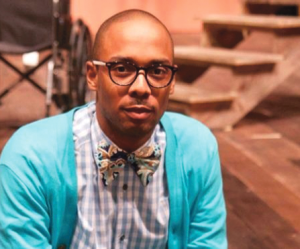
Professor Isaiah Wooden (COL ’04) directs a new collaborative production of “In the Red and Brown Water”
A new production of “In the Red and Brown Water,” co-produced by the Black Theatre Ensemble and the Theater and Performance Studies program, opens this week and runs through Oct. 18. This poetic, powerful play written by Tarell Alvin McCraney is directed by Guest Artist and Lecturer in Theater and Performance Studies, professor Isaiah Matthew Wooden (COL ’04). A recipient of the 2014-2015 Ford Foundation Dissertation Fellowship, Wooden explains the unique nature of this production.
How did you come to choose this play?
I’ve wanted to direct “In the Red and Brown Water” since first reading the play in American Theater Magazine in 2008. As a director, I’m always looking for projects that will allow me to flex critical and creative muscles. The play’s beautiful mixing of myth, music and the mundane landed it a spot on the top of my list of dream projects. Thus, when discussions began between the Theater and Performance Studies Program and Black Theatre Ensemble last year about a collaborative production, I offered it as the play I’d most like to direct. I thought it would resonate powerfully with the Georgetown community. Undoubtedly, it is one of the most compelling 21st century theater texts.
What do you think is the most striking aspect of the production?
Audiences will find McCraney’s lush, poetic language and vivid storytelling most striking, I think. As a way to help remind [them] of the communal aspects and functions of theater and to create the sense that we — performers and spectators — are all journeying together, McCraney has each character in the play announce their stage directions. This creates a unique experience for playgoers; it presents theater as storytelling.
Why do you think this is an important play for the Georgetown community to see? Do you think there is some significance to putting on a production about a young person at a crossroad in life, while seeking to make a mark on the world, at Georgetown in particular?
Perhaps what I love most about this play are the ways it throws into question our investments in notions of progress. Oya, the play’s central character, is a seeming emblem of “bad timing.” What I hope her inability to come to the “right” decision on time will invite audiences to consider are the rich possibilities for life and living outside of those rigidly constructed notions of success that cannot account for change. The play reminds that change happens — resistance is futile.
How did you go about casting for this production and is there anything special about this cast?
We had a pretty typical casting process. However, because of the way the play engages music and dance, I was especially looking for actors who could sing and move.
How did you get the cast to prepare for their roles?
I always try to create space in the rehearsal room for experimentation — that is, for performers to make bold choices and to stay present to any discoveries. We play. A lot of what audiences will see on stage emerged from improvisations in the rehearsal room.
We were able to host the playwright Tarell McCraney for two days early in our process. He was extremely gracious and generous and answered the many questions we had about the play. He also offered tips on how the performers might address some of the challenges that the play poses.
What were the challenges you faced in putting on this production?
We’ve had a pretty challenge-free production process. Of course, I always long for more time. As the first theater production opening on campus this season, our rehearsal process was slightly truncated. Accordingly, we have been rehearsing fairly intensively for the past four weeks. Thankfully, we had an amazing group of performers who were game.
How does directing this play compare to your previous directing experience at Georgetown?
To be sure, the opportunity to work with the bright, generous students at Georgetown again is a gift. What made this project especially wonderful was the ensemble. They’re bringing so much energy and life to these characters.
Do you think that African-American playwrights are under-recognized, particularly at universities like Georgetown?
At Georgetown, in particular, there is a strong commitment to presenting the work of a diverse range of artists. I have directed four works by African-American playwrights on campus in recent years and have been impressed by the ways the community has supported each one of them. Of course, in the larger world, institutional structures do exist that constrain possibilities for the work of black artists (and, indeed, artists of color more generally) to receive full hearings and/or viewings. This is, in part, why I try to hold up that work any chance that I get.


















